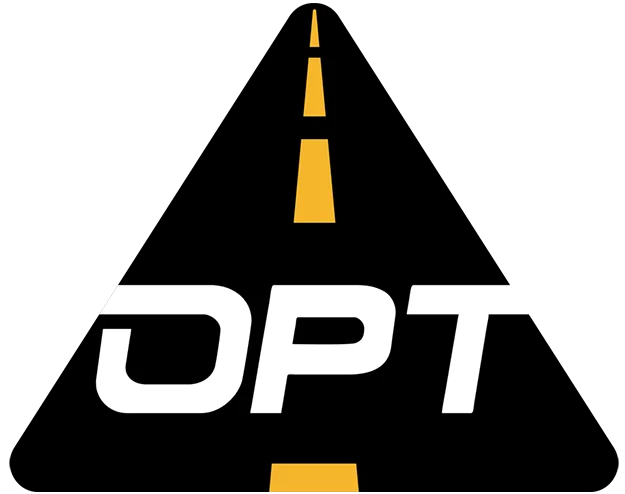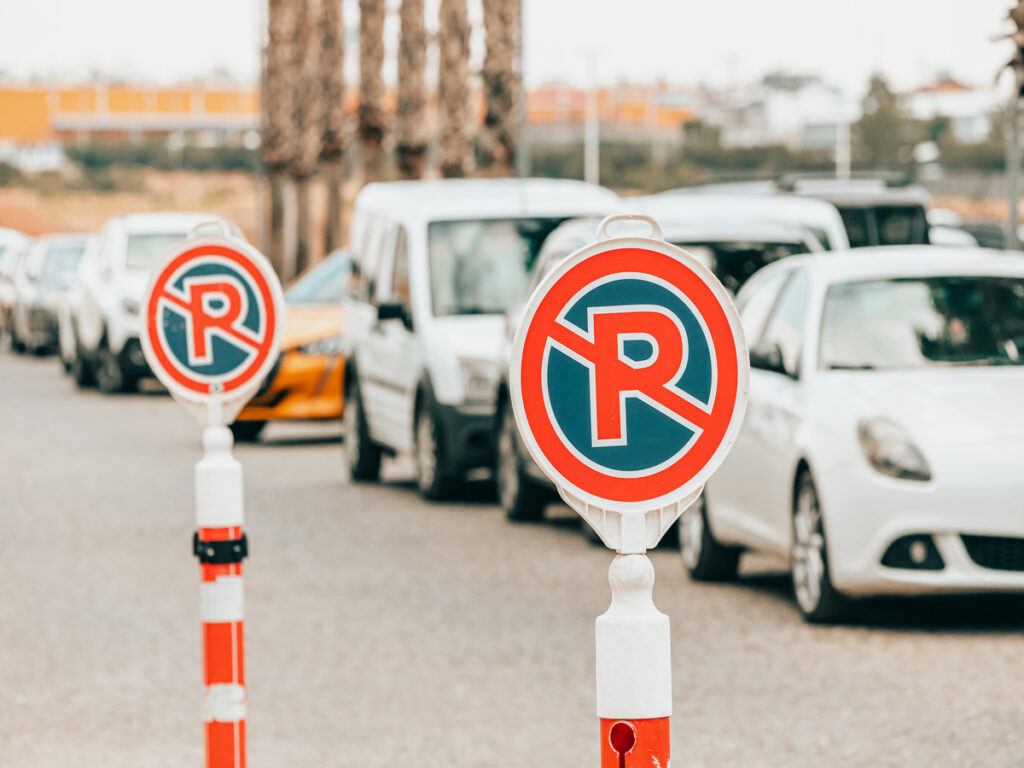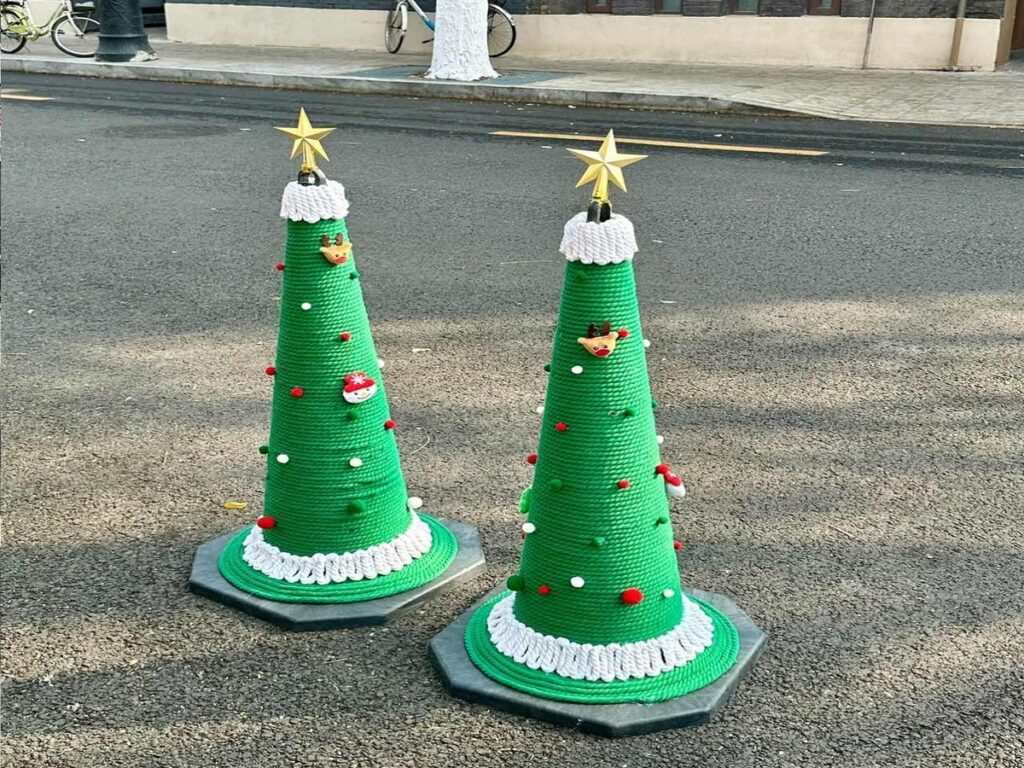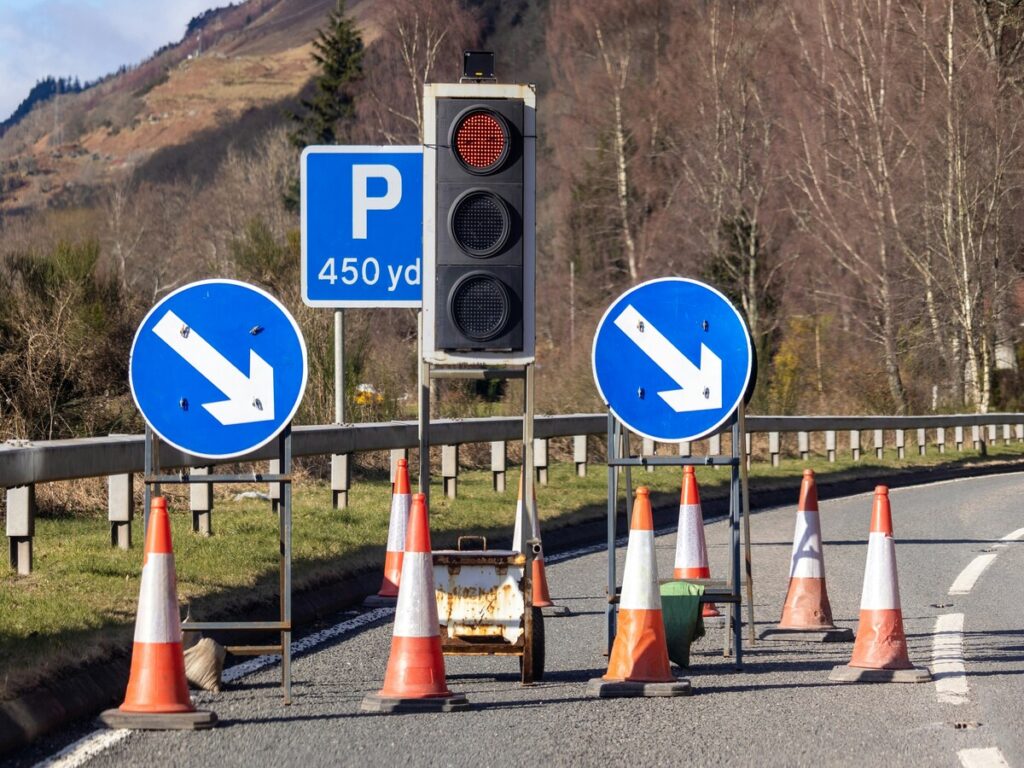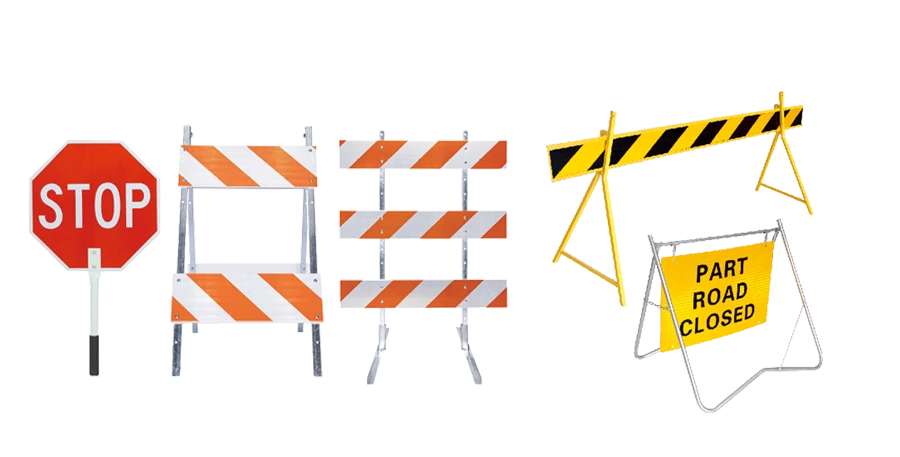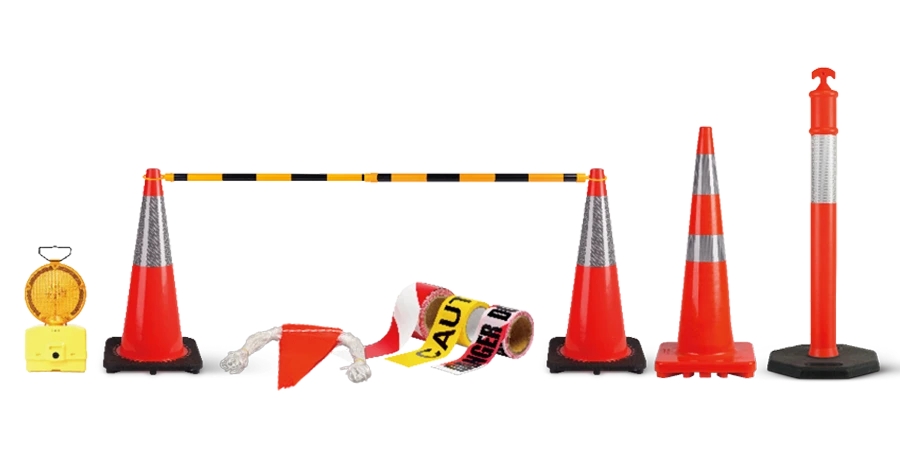
Os sinais de trânsito são cruciais para a segurança. Eles fornecem instruções e avisos claros para motoristas e pedestres. A cor dos sinais e significados da estrada é padronizada para que todos possam entendê -los rapidamente. Por exemplo, vermelho significa parada ou perigo, Enquanto amarelo alerta sobre riscos potenciais à frente. Esses significados de cores seguem as diretrizes do Manual sobre Dispositivos Uniformes de Controle de Tráfego (MUTCD), garantindo consistência nos EUA. e tornar as estradas mais seguras e menos confusas.
O design eficaz também melhora a visibilidade e a legibilidade dos sinais. Materiais reflexivos brilhantes e formas simples ajudam você a perceber os sinais imediatamente. Isso facilita a tomada de decisões informadas, reduz acidentes, e contribui para estradas mais seguras para todos.
OPTRAFFIC oferece uma ampla gama de sinais de trânsito de alta qualidade à venda projetado para máxima visibilidade e segurança. Os sinais de segurança de trânsito OPTRAFFIC são construídos para atender aos padrões MUTCD e estão equipados com materiais duráveis, materiais reflexivos para maior legibilidade e eficácia.
Takeaways -chave
- Sinais de trânsito usam cores para compartilhar mensagens importantes. Vermelho significa parada ou perigo, e amarelo avisa para ter cuidado. Conhecer essas cores ajuda você a agir rápido.
- As formas dos sinais de trânsito são feitas para serem claras. Octógonos significam parada, triângulos significam rendimento, e círculos mostram regras. Conhecer essas formas torna as estradas mais seguras.
- Um bom design de sinalização torna-os fáceis de ver. Cores brilhantes, Materiais brilhantes, e formas simples ajudam os motoristas a perceber os sinais rapidamente, redução de acidentes.
- As cores brilhantes são muito importantes em zonas escolares e áreas de construção. Esses sinais se destacam, mesmo com pouca luz ou mau tempo.
- Aprender os sinais de trânsito e o que eles significam ajuda você a dirigir com segurança. Seguir estes sinais mantém as estradas seguras e protege a todos.
Por que os sinais de trânsito são importantes para a segurança no trânsito

A sinalização de trânsito é fundamental para manter as estradas seguras e organizadas. Eles orientam motoristas e caminhantes, reduzir a confusão, e manter o tráfego fluindo sem problemas. Saber por que os sinais de trânsito são importantes com a cor e o significado dos sinais de trânsito pode ajudá-lo a fazer melhores escolhas durante a viagem.
Compartilhando mensagens importantes
Os sinais de trânsito funcionam como uma linguagem partilhada por todos na estrada. Eles fornecem detalhes importantes de forma rápida e clara. Por exemplo, sinais de segurança no trânsito como “Entrada proibida” ou “Vire à esquerda” dizer-lhe as regras a seguir. Sinais de aviso, como “Cruzamento de pedestres,” alertá -lo para os perigos à frente. Outras placas compartilham informações úteis sobre lugares, rotas, ou distâncias.
| Tipo de sinal | O que faz | Exemplos |
|---|---|---|
| Sinais de regra | Mostrar regras a serem seguidas para segurança e ordem. | 'Vire à esquerda', 'Entrada proibida’ |
| Sinais de aviso | Avisar sobre perigos ou condições incomuns à frente. | ‘Curve-se para frente’, ‘Passagem de pedestres’ |
| Sinais de informação | Dê detalhes sobre rotas, distâncias, ou serviços próximos. | ‘Posto de gasolina’, 'Hospital’ |
Estudos dizem que os sinais de LED ajudam os motoristas a reagir mais rapidamente e a reduzir as taxas de acidentes. Estes sinais funcionam bem em cidades movimentadas, reduzindo os engarrafamentos e tornando as estradas mais seguras..
Prevenindo Acidentes e Mantendo a Ordem
A sinalização rodoviária é muito importante para prevenir acidentes. Sinais de limite de velocidade ajudam motoristas a manter velocidades seguras, diminuindo os riscos de colisão. Sinais de estacionamento evitam problemas causados por mau estacionamento. Sinais em forma de diamante alertam sobre curvas fechadas ou estradas escorregadias, dando-lhe tempo para ter cuidado.
| Tipo de sinal de trânsito | Como ajuda a manter as estradas seguras |
|---|---|
| Sinais de limite de velocidade | Mostrar a velocidade máxima permitida para evitar acidentes. |
| Sinais de estacionamento | Informe onde é permitido estacionar para evitar acidentes. |
| Sinais de lei | Ajude os motoristas a seguir as regras e evitar infringir as leis. |
| Sinais de aviso | Alertar sobre perigos para que os motoristas possam ficar seguros. |
Seguindo estes sinais, você ajuda a manter as estradas seguras e o trânsito fluindo suavemente. Isso protege você e outras pessoas.
Símbolos fáceis de entender para todos
Os símbolos de trânsito são feitos para serem compreendidos por todos, não importa de onde eles sejam. Os EUA. O Departamento de Transportes criou regras para facilitar a leitura desses símbolos, mesmo quando dirigindo rápido. Imagens são usadas em vez de palavras porque são mais fáceis de reconhecer e trabalhar em vários idiomas. Por exemplo, um sinal de pare ou um símbolo de cruzamento é conhecido mundialmente.
- Os símbolos ajudam pessoas de diferentes lugares a entender os sinais rapidamente.
- Sinais claros diminuem a confusão e reduzem os acidentes, estudos mostram.
- Os engenheiros continuam melhorando os projetos para tornar a sinalização mais eficaz.
Sinais de trânsito universais garantem que todos possam viajar com segurança, Não importa onde eles estejam. Estas normas partilhadas mostram a importância dos sinais de trânsito para estradas mais seguras em todo o mundo.
A cor dos sinais de trânsito e seus significados
Sinais de trânsito usam cores para compartilhar mensagens importantes. Conhecer a cor dos sinais de trânsito e seus significados ajuda você a entender os sinais rapidamente. Cada cor tem um papel especial, criando um sistema compartilhado que mantém as estradas seguras.
Vermelho: Pare e Perigo
Vermelho é fácil de perceber e significa parada ou perigo. Ele chama a atenção rapidamente e avisa para ter cuidado. Você vê vermelho nos sinais de parada, sinais de proibição de entrada, e outros sinais de alerta. Seu visual brilhante diz para você agir rapidamente para se manter seguro.
Observação: O vermelho é conhecido mundialmente por significar parada ou perigo. Por exemplo, os sinais de parada usam vermelho com letras brancas para torná-los claros.
| Tipo de sinal | Forma | Cor de fundo | Cor da borda | Tamanho (Grande/Pequeno) | Cor do símbolo | Exemplos |
|---|---|---|---|---|---|---|
| Sinal de alerta de perigo | Triângulo | Branco/Amarelo | Vermelho | 0.9m / 0.6m | Preto/Azul | Curva acentuada à frente |
| Sinais proibitivos | Círculo | Branco/Amarelo | Vermelho | 0.6m / 0.4m | Preto/Azul | Entrada proibida |
O visual arrojado do Red o torna perfeito para mostrar perigo e regras.
Amarelo: Tome cuidado
Amarelo significa cautela. Ele avisa sobre riscos ou mudanças futuras. Sinais como “Estrada escorregadia” ou “Zona escolar” use amarelo para chamar sua atenção e lembrá-lo de dirigir com cuidado.
Estudos mostram que sinais amarelos funcionam bem para alertar os motoristas. Por exemplo:
- Sinais amarelos piscantes desaceleram os carros melhor do que os normais (Lyles, 1981).
- Sinais amarelos brilhantes ajudam os motoristas mais velhos a enxergar melhor durante o dia (Jenssen et al., 1996).
O brilho do amarelo facilita a visualização, Mesmo com pouca luz. Isso a torna uma cor chave para segurança.
Verde: Direções e ações permitidas
Verde mostra rotas e informa o que é permitido. Você verá sinais verdes nas rotas, saídas, e lugares. Os sinais de trânsito usam verde para mostrar distâncias e direções claramente.
Dica: Nos EUA, sinais verdes ajudam você a encontrar seu caminho facilmente.
Verde se sente calmo, ao contrário da urgência do vermelho ou amarelo. Ele informa que a estrada à frente é segura e fornece informações úteis sobre viagens.
Aprender essas cores dos sinais de trânsito ajuda você a entender melhor os sinais. Isso melhora sua segurança e confiança ao dirigir.
Azul: Sinais para informações e direções
Sinais azuis fornecem informações úteis e orientam você nas estradas. Eles mostram serviços, regras, ou direções. Por exemplo, sinais azuis apontam para hospitais, postos de gasolina, ou paradas para descanso. Eles também mostram distâncias ou ajudam você a seguir rotas.
- Sinais azuis funcionam como mapas, mostrando rotas de viagem claras.
- Eles fornecem regras como qual faixa usar ou mudanças de velocidade.
- Você também verá sinais azuis para rotas de evacuação ou pontos turísticos.
Azul é uma cor calma, perfeito para orientar em vez de avisar. Sua aparência única facilita a identificação entre outros sinais. Conhecendo os sinais azuis, você pode fazer escolhas inteligentes e viajar com segurança.
Branco e Preto: Regras e mensagens claras
Branco e preto são usados para sinais de regras. Esses sinais mostram regras de trânsito, como limites de velocidade, Pontos de estacionamento, ou uso da pista. Seu design simples os torna fáceis de ler. Por exemplo, uma placa branca com letras pretas pode mostrar um limite de velocidade. Uma placa com borda preta pode significar proibição de estacionamento.
- A maioria dos sinais de regras mistura branco e preto para melhor visibilidade.
- Suas formas e cores são projetadas para chamar sua atenção.
- Alguns sinais de regras adicionam vermelho ou verde para atenção extra.
Esses sinais de trânsito são essenciais para manter as estradas seguras e organizadas. Segui-los ajuda a evitar confusão e mantém o trânsito tranquilo.
Laranja: Avisos para mudanças temporárias
Sinais laranja alertam sobre mudanças temporárias, como obras rodoviárias ou construções. Esses sinais dizem para você ter cuidado e orientá-lo em novas condições. Por exemplo, um sinal de diamante laranja pode alertar sobre faixas fechadas ou desvios.
| Estudar | O que encontrou |
|---|---|
| Lyles (1981) | Sinais laranja piscantes desaceleram melhor os carros perto de pistas fechadas. |
| Jenssen et al. (1996) | Materiais brilhantes ajudam os motoristas mais velhos a enxergar melhor à luz do dia. |
| Queimaduras e Pavelka (1995) | Laranja fluorescente funciona bem com mau tempo. |
| Hummer e Scheffler (1999) | Sinais laranja fluorescentes reduzem problemas de trânsito em 7%. |
Laranja é muito visível, Mesmo com pouca luz. Prestar atenção a esses sinais ajuda a evitar o perigo e a permanecer seguro.
Cores Fluorescentes: Mantendo as zonas escolares e os pedestres seguros
As cores fluorescentes ajudam a manter as zonas escolares e os pedestres seguros. Essas cores brilhantes são fáceis de ver, Mesmo com mau tempo. Você notará sinais verde-amarelos fluorescentes perto de escolas e faixas de pedestres. Eles lembram os motoristas de diminuir a velocidade e ficar atentos às pessoas andando.
Estudos mostram que sinais fluorescentes tornam as estradas mais seguras. Por exemplo:
- Os problemas de trânsito diminuíram 153 para 136 com sinais fluorescentes.
- Menos carros permaneceram na faixa da esquerda nesses locais.
- Caminhoneiros saíram da faixa da esquerda 30% mais frequentemente com esses sinais.
- Os motoristas disseram que os sinais laranja fluorescentes eram mais fáceis de notar.
- Sinais fluorescentes brilhantes foram vistos quase 100% da época, mesmo longe.
Esses estudos comprovam que as cores fluorescentes melhoram a segurança e a visibilidade. Quando você vê esses sinais em zonas escolares, é mais provável que você desacelere. Isso ajuda a prevenir acidentes e mantém crianças e caminhantes seguros.
Sinais fluorescentes também funcionam bem em áreas de construção. Seu visual brilhante faz com que eles se destaquem de outros signos. Isso ajuda os motoristas a permanecerem seguros nas mudanças nas condições da estrada. Observar esses sinais de segurança no trânsito ajuda todos a permanecerem seguros.
Saber por que as cores fluorescentes são importantes ajuda você a dirigir de maneira mais inteligente. A cor dos sinais de trânsito e os significados desempenham um papel fundamental para tornar os sinais mais visíveis e eficazes. Esses sinais de segurança no trânsito não são apenas brilhantes – eles salvam vidas ao proteger as pessoas na estrada.
O papel das formas nos sinais de trânsito
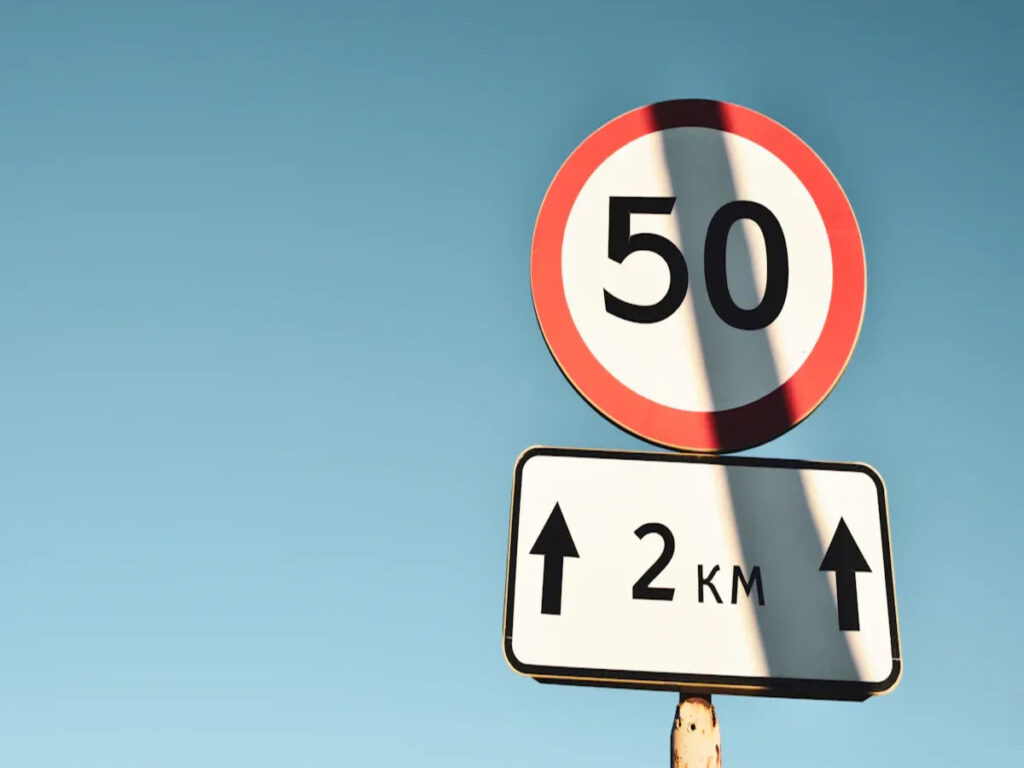
Os sinais de trânsito usam formas para compartilhar mensagens com clareza. Cada forma tem uma função, ajudando você a saber rapidamente o que fazer. Aprender essas formas ajuda você a reagir melhor e mantém as estradas mais seguras.
Octagonos: STOP SIGNS
Os octógonos são fáceis de reconhecer na estrada. Seus oito lados e sua cor vermelha brilhante significam “parar” agora mesmo. Mesmo que parte da placa esteja oculta, você ainda pode dizer que é um sinal de pare. Esses sinais são compreendidos em todos os lugares e ajudam a manter os cruzamentos seguros. Seu formato exclusivo ajuda os motoristas a parar rapidamente, diminuindo os riscos de colisão.
Você sabia? Os octógonos foram escolhidos para sinais de parada porque se destacam. Os motoristas podem identificá-los de longe ou com mau tempo.
Triângulos: Rendimento e sinais de alerta
Triângulos são importantes para a segurança no trânsito. Triângulos descendentes significam “colheita.” Eles dizem para você ir mais devagar e deixar os outros irem primeiro. Seus ângulos agudos chamam sua atenção, Mesmo em nevoeiro ou à noite.
Triângulos ascendentes alertam sobre perigos futuros. Eles informam sobre curvas fechadas ou fusão de faixas para que você possa ter cuidado. Esses dois usos de triângulo fornecem avisos e instruções claras.
- Triângulos descendentes: Dizer para você ceder e manter o tráfego tranquilo.
- Triângulos ascendentes: Avise sobre perigos para ajudá-lo a se manter seguro.
Retângulos e Quadrados: Sinais Informativos e Regulatórios
Retângulos e quadrados são usados para muitos sinais de trânsito. Retângulos verticais mostram regras como limites de velocidade ou vagas de estacionamento. Retângulos horizontais fornecem informações úteis, como onde estão postos de gasolina ou hospitais.
Essas formas são simples e fáceis de ler. Eles ajudam você a seguir regras e encontrar serviços rapidamente. Prestar atenção a esses sinais torna as estradas mais seguras e organizadas.
Dica: Observe atentamente os sinais retangulares. Eles geralmente contêm informações importantes para ajudá-lo a dirigir com segurança e facilidade.
Círculos: Sinais para regras e ações
Sinais de trânsito redondos ajudam a manter as estradas seguras e organizadas. Estas placas mostram regras que você deve seguir ao dirigir. A sua forma circular torna-os fáceis de perceber e compreender rapidamente.
Sinais com borda vermelha e fundo branco ou amarelo significam “não faça nada.” Por exemplo, “Sem inversão de marcha” ou “Proibido Estacionar” sinais usam esse estilo. A borda vermelha se destaca, dizendo para você parar ou evitar certas ações.
Placas com fundo azul e símbolos brancos indicam o que fazer. Exemplos incluem “Vire à esquerda” ou “Mantenha certo.” Esses sinais são simples e claros, para que você possa lê-los mesmo quando estiver dirigindo rápido. Eles ajudam a orientar o tráfego e evitar confusão.
Aqui está um resumo dos sinais de trânsito redondos:
| Tipo de sinal | Forma | Cor de fundo | Fronteira | Tamanho | Cor do símbolo |
|---|---|---|---|---|---|
| Proibitório | Círculo | Branco ou Amarelo | Vermelho | 0.6 m (grande), 0.4 m (pequeno) | Preto ou Azul Escuro |
| Obrigatório | Círculo | Azul | Nenhum | 0.6 m (grande), 0.4 m (pequeno), 0.3 m (pequeno) | Branco |
Conhecer esses sinais ajuda você a seguir as regras de trânsito e a se manter seguro.
Diamantes: Sinais de aviso
Sinais em forma de diamante alertam sobre perigos ou mudanças na estrada. Suas cores brilhantes e formato único tornam-nos fáceis de ver. Isso lhe dá tempo para reagir e permanecer seguro.
Você verá frequentemente esses sinais em áreas de construção ou locais com riscos. Por exemplo, sinais de diamante podem alertar sobre estradas escorregadias, curvas fechadas, ou pedras caindo. Em zonas de construção, eles informam sobre fechamentos ou desvios de faixa. Isso lembra você de desacelerar e ter cuidado.
| Onde usado | O que isso diz a você |
|---|---|
| Áreas de Construção | Alerta sobre obras rodoviárias, então você diminui a velocidade e fica alerta. |
| Condições de risco | Alerta você sobre perigos como curvas fechadas, estradas escorregadias, ou pedras caindo. |
Observar os sinais em forma de diamante ajuda você a dirigir com segurança em situações complicadas. Esses sinais são importantes para manter todos seguros na estrada.
Princípios de Design para Sinais de Trânsito Eficazes
Visibilidade e legibilidade
Bons sinais de trânsito são fáceis de ver e ler. Os motoristas precisam entendê-los rapidamente para se manterem seguros. Várias coisas ajudam a tornar os sinais mais visíveis e legíveis:
| Princípio | O que isso significa |
|---|---|
| Tamanho do sinal | Letras maiores são mais fáceis de ler, especialmente à noite. |
| Largura do traço | Linhas mais grossas ajudam os motoristas mais velhos a ver melhor os sinais. |
| Contraste | Contraste forte, como preto em laranja, faz os sinais se destacarem. |
| Materiais Fluorescentes | Materiais brilhantes tornam os sinais visíveis em qualquer clima. |
| Uso de símbolos | As imagens ajudam as pessoas a entender os sinais mais rápido do que as palavras. |
| Assinatura Redundante | Sinais extras garantem que os motoristas os vejam, especialmente em zonas de trabalho. |
Estas ideias garantem que os sinais funcionem bem em todas as condições. Por exemplo, materiais brilhantes ajudam durante o dia, e forte contraste ajuda à noite. Esses designs mantêm os motoristas informados e seguros.
Simplicidade e Clareza
Sinais simples são os melhores para manter os motoristas seguros. Sinais complicados podem confundir as pessoas e causar acidentes. Pesquisa mostra sinais claros que ajudam os motoristas a fazer melhores escolhas. Um básico “Parar” assinar com letras em negrito e fundo vermelho é fácil de entender.
Sinais claros também são importantes. Sinais com menos palavras e símbolos comuns são mais rápidos de ler. Isso significa que os motoristas gastam menos tempo descobrindo a sinalização e mais tempo concentrados na estrada. Mantendo os sinais simples e claros, regras de trânsito são mais fáceis de seguir.
Psicologia do contraste e das cores
O contraste e as cores afetam a forma como você percebe os sinais de trânsito. Alto contraste, como letras pretas em laranja, torna os sinais mais fáceis de ver. Os sinais laranja brilhante são ainda mais perceptíveis do que os laranja normais. Estudos mostram que esses sinais ajudam os motoristas a reagir mais rapidamente e a evitar problemas.
- Sinais laranja brilhantes são mais fáceis de ver em todas as condições de iluminação.
- Os motoristas reagem mais rapidamente aos sinais luminosos, diminuindo os riscos de acidentes.
- Estradas com sinalização clara têm menos acidentes do que aquelas com sinalização fraca.
As cores também mudam a forma como você se sente em relação aos sinais. Por exemplo, a cor dos sinais de trânsito e significados: vermelho significa perigo ou parar, então você age rápido. Green se sente calmo e ajuda a guiá-lo com segurança. Essas escolhas inteligentes de cores garantem que as placas chamem sua atenção e mantenham você seguro.
Durabilidade e seleção de materiais
Materiais fortes são fundamentais para uma durabilidade Sinais de trânsito. Os sinais devem lidar com o mau tempo, sol brilhante, e roupas ao ar livre. Usar os materiais certos mantém a sinalização clara e útil por anos. Materiais reflexivos, como alumínio com revestimentos brilhantes, são frequentemente usados. Isso torna os sinais mais fáceis de ver à noite ou na chuva, melhorando a segurança.
Bons materiais também economizam dinheiro em reparos. Os revestimentos UV param de desbotar com a luz solar. Metais sem ferrugem, como alumínio, fique forte em tempo chuvoso. Plásticos e compósitos leves funcionam bem para sinalização temporária em zonas de trabalho.
Dica: Escolha sempre materiais que sigam as regras de segurança. Isso garante que os sinais funcionem bem e atendam aos padrões.
Posicionamento estratégico para máxima eficácia
Onde você coloca Sinais de trânsito é tão importante quanto a aparência deles. Os sinais devem estar ao nível dos olhos e fáceis de detectar. Isso ajuda motoristas e caminhantes a vê-los rapidamente, sem distrações.
Não amontoe muitos sinais. Espalhe-os para que os motoristas possam ler cada um deles. Por exemplo, os sinais de alerta devem estar suficientemente à frente dos perigos para dar tempo de reagir.
Pense também nos arredores. Não coloque sinais onde árvores ou edifícios os bloqueiem. Em áreas com neblina ou chuva, use sinais reflexivos ou iluminados para mantê-los visíveis.
O posicionamento inteligente faz Sinais de trânsito mais útil. Ajuda as pessoas a vê-los e compreendê-los, manter as estradas seguras e ordenadas.
Padronização Global e Variações Regionais
A Convenção de Viena sobre Sinais e Sinais Rodoviários
A Convenção de Viena ajuda a tornar Sinais de trânsito o mesmo em todo o mundo. Este tratado, criado em 1968, garante que os motoristas entendam os sinais em qualquer país. Em outubro 2022, 71 países aderiram, e 35 assinou. Melhora a segurança e reduz a confusão para os viajantes.
O tratado estabelece regras para design de sinalização, cores, e significados. Por exemplo, verde significa “ir,” Red significa “parar,” e âmbar avisa para parar se for seguro. A tabela abaixo mostra algumas regras principais:
| Tipo | Forma | Cor | Posição | Significado |
|---|---|---|---|---|
| Não piscando | Simples | Verde | Em cruzamentos ou túneis | Ir |
| Âmbar | Em travessias ou terminais de ferry | Pare se for seguro | ||
| Vermelho | Nos cruzamentos | Parar | ||
| Piscando | Simples | Duplo Vermelho | Em passagens de nível ou quartéis de bombeiros | Parar |
| Âmbar (piscando) | Em qualquer lugar, exceto cruzamentos | Seja cauteloso |
Estas regras tornam a sinalização mais fácil de entender e mais segura para todos.
Diferenças regionais em cores e símbolos
Mesmo com regras globais, algumas regiões usam diferentes Sinais de trânsito. Os países escolhem cores e símbolos com base na cultura local. Por exemplo:
| Região | Uso de cores | Uso de símbolos |
|---|---|---|
| América do Norte | Amarelo para avisos, verde para rodovias | Sinais de texto como “PARAR” com símbolos |
| Europa | Branco com bordas vermelhas para avisos | Principalmente símbolos, como octógonos vermelhos para “PARAR” |
| Japão | Azul para rodovias | Símbolos especiais, como triângulos invertidos para rendimento |
| Austrália | Segue AS 1742 diretrizes | Combina regras locais e globais |
No Japão, sinais de trânsito azuis substituem os verdes, o que pode confundir os visitantes. Europa usa mais fotos, enquanto os EUA. adiciona texto. Estas diferenças mostram como as regiões misturam regras globais com necessidades locais.
Exemplos de sinais de trânsito exclusivos em todo o mundo
Alguns países têm especial Sinais de trânsito para sua cultura ou ambiente. Aqui estão alguns exemplos:
- Japão: Os sinais de parada são triângulos invertidos com “PARAR” em dois idiomas.
- Estados Unidos: Os sinais de parada são octógonos vermelhos com letras brancas em negrito.
- Reino Unido: Os sinais de stop muitas vezes ignoram o texto, usando apenas a forma de octógono vermelho.
- Etiópia: Sinais manuais substituem sinais de parada, combinando tradições locais.
- Papua Nova Guiné: Os sinais de parada têm formatos únicos, ao contrário dos padrões globais.
- Nepal: Os sinais de parada são octógonos vermelhos simples, sem texto ou símbolos.
Estes exemplos mostram como os sinais se adaptam às necessidades locais, mas ainda mantêm as estradas seguras.
Conhecer os sinais de trânsito é importante para se manter seguro nas estradas. A cor dos sinais de trânsito e seus significados fornecem mensagens claras que ajudam você a tomar decisões rápidas. Bons designs tornam os sinais fáceis de ver e entender, reduzindo confusão e travamentos. Seguir as regras de trânsito mantém todos seguros e evita perigos.
Novas ideias em design de sinalização trazem grandes oportunidades. Melhores materiais e tecnologia inteligente podem melhorar o funcionamento da sinalização. Por exemplo, a cor dos sinais de trânsito e seus significados desempenham um papel crucial na transmissão rápida de informações importantes. Essas mudanças tornam as estradas mais seguras e as viagens mais fáceis para todos. Aprender sobre essas atualizações ajuda você a dirigir com segurança e mantém o trânsito tranquilo.
Quer saber mais sobre a cor dos sinais de trânsito e seus significados?
Confira nosso blog ou entre em contato OPTRÁFEGO hoje para obter insights de especialistas e sinais de trânsito de alta qualidade projetados para aumentar a segurança e a eficiência na estrada.
Perguntas frequentes
O que significam as diferentes cores dos sinais de trânsito?
Cada cor tem uma função. Vermelho significa perigo ou parada. Amarelo alerta para ter cuidado. Verde mostra direções. Azul fornece informações úteis. Laranja sinaliza mudanças temporárias. Cores fluorescentes brilhantes são para zonas escolares ou áreas de construção. Conhecer essas cores ajuda você a reagir corretamente.
Por que os sinais de trânsito têm formatos diferentes?
As formas enviam mensagens claras. Octógonos significam parada. Os triângulos avisam ou dizem para você ceder. Retângulos mostram regras ou fornecem informações. Os círculos mostram ações que você deve seguir ou coisas que você não pode fazer. Diamantes alertam sobre perigos. Aprender essas formas ajuda você a entender os sinais mais rapidamente.
Como os sinais fluorescentes melhoram a segurança?
Sinais fluorescentes são fáceis de ver com mau tempo ou pouca luz. Suas cores brilhantes chamam sua atenção, Mesmo de longe. Estes sinais funcionam bem em zonas escolares e áreas de construção onde a segurança é muito importante.
Os sinais de trânsito são iguais em todo o mundo??
Muitos países seguem regras globais como a Convenção de Viena. Mas alguns lugares têm diferenças. Por exemplo, Japão usa azul para rodovias, enquanto os EUA. usa verde. Aprender as regras locais ajuda você a se manter seguro ao viajar.
Quais materiais tornam os sinais de trânsito duráveis?
Os sinais de trânsito são feitos de materiais resistentes, como alumínio ou plástico. Revestimentos reflexivos ajudam você a vê-los à noite. A proteção UV para de desaparecer. Esses materiais mantêm a sinalização clara e útil por muito tempo, Mesmo em clima difícil.
